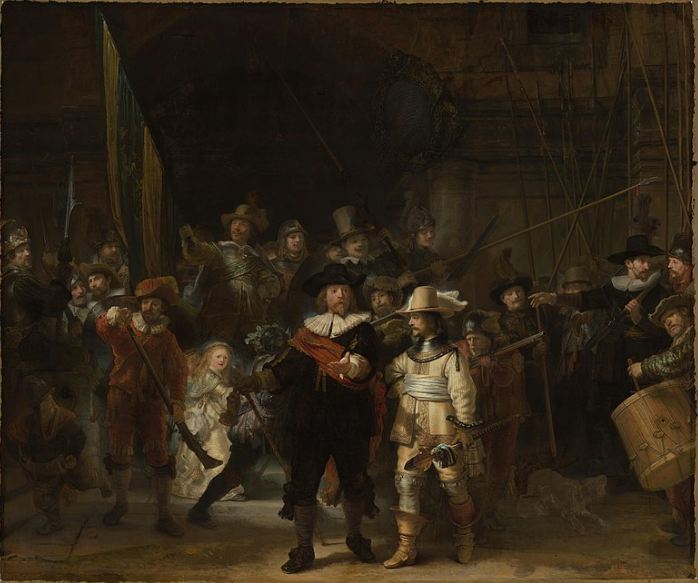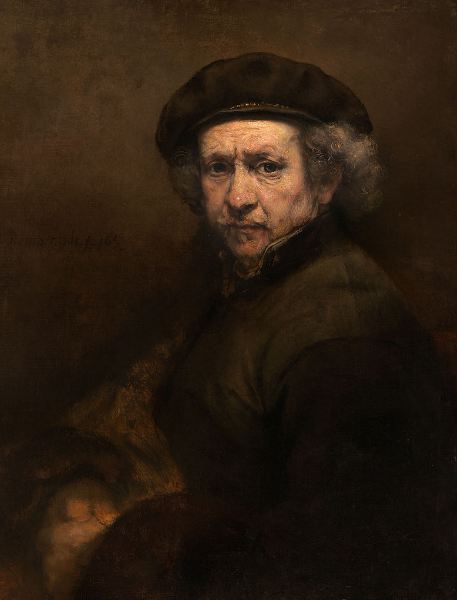The Night Watch is the shortened name of the painting created by Rembrandt van Rijn in 1642. The painting’s original name is “Militia Company of District II under the Command of Captain FransBannickCocq.” However, it is commonly referred to now as “The Night Watch,” since that was the nickname given to the group of militia guards depicted in the painting. The Night Watch is particularly famous for its enormous size (142.9 inches in length and 172 inches in width) and also for its superb use for tenebrism or dramatic illumination, which allows exaggerated contrasts in light and shadow in several parts of the painting.
Furthermore, the painting highlights three prominent figures using dramatic illumination, and these figures are the leader of the group (Captain FransBannickCocq), his lieutenant (Willem van Ruytenburch), and a woman located to the middle left of the painting. The woman is supposed to serve as a mascot for the group, as she carries with her the main symbols of The Night Watch, which are the claw of the chicken (the arquebusiers in the group) and the goblet of the militia. It is also important to note that the chicken that she is carrying in the painting is dead, and some art interpreters suggest that the dead chicken is supposed to represent a defeated enemy of The Night Watch. The yellow dress that she is wearing is also meant to represent the victory of the group, as the said color is often associated with winning. To know more about how the painting came to be and what led Rembrandt to create it, here are the interesting origins of The Night Watch.
Origins
According to historical records, The Night Watch was commissioned in 1639 by Captain BannickCocq and seventeen other members of the group called “Kloveniers,” who are the civic militia guards in the medieval Netherlands. The group gave Rembrandt 1,600 guilders to paint the artwork, and that amount of money was considered to be a lot during that period. It is believed that each person in the group contributed 100 guilders for Rembrandt’s payment, but one particular member (the hired drummer) did not pay since he was allowed to be in the painting for free.
The militia guards commissioned the painting to be placed in the banquet hall of their newly-built headquarters, the “Kloveniersdoelen” or Musketeers’ Meeting Hall. Besides The Night Watch, there also six other paintings commissioned by Captain BannickCocq’s group, but those were not painted by Rembrandt. Historians have speculated that the militia guards commissioned a lot of paintings during that time in order to impress the then-French queen, Marie de Medici, in 1638.
There are several theories being discussed today regarding how Rembrandt was able to paint such a humongous painting. One theory suggests that Rembrandt renovated his home with a larger studio, and this theory is strengthened by a historical record saying that the painter applied for the construction of a “summer kitchen” at the back of his home. Another theory is that Rembrandt actually painted it in the Musketeers’ Meeting Hall, although some argued that Rembrandt being there most of the time would have rendered the room useless for the militia guards, who were known to conduct meetings in the same place. The location of where Rembrandt painted is still being debated until today.
Movement and Alterations
The painting was first placed on one of the walls of the Musketeer’s Meeting Hall after Rembrandt finished creating it. The Night Watch remained there until 1715 when it was transferred to the Amsterdam Town Hall. Unfortunately, the painting was too large for any walls in the said town hall, so the people who moved it were forced to trim three of its sides. Because of the trimming, the two characters located at the far left were removed.
When the Netherland was occupied by Napoleon and his army, the Amsterdam Town Hall was renamed “The Palace on the Dam,” and The Night Watch was moved to a nearby mansion owned by the Trip family. The mansion, which was once named “Trippenhuis,” is currently the Dutch Academy of Sciences. The Night Watch was then moved again in 1885 to the Rijksmuseum, a national museum that focuses on highlighting the art and history of Amsterdam.
The painting was hidden by the management of the Rijksmuseum in September 1939, and it was rolled around to form a cylinder. To preserve it, the Rijksmuseum sent the painting to the caves in Maastricht, Netherland, a location known to preserving and protecting artworks. After four years of being hidden, it returned to the Rijksmuseum.
In 2003, the painting was moved once again because the Rijksmuseum was being refurbished. It was still being displayed in the same museum, but it was moved to a separate room called the “Philipsvleugel.” When the refurbishment was finished, the painting was returned to its original room at the museum called the “Nachtwachtzaal” or Room of the Night Watch. The Night Watch has been in display at the Rijksmuseum for more than 120 years.


